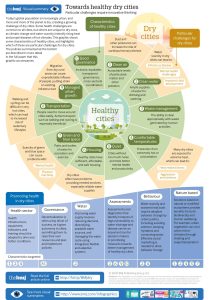Protecting Health in Dry Cities: Considerations for Policy Makers
Citation
Frumkin, H., Das, M. B., Negev, M., Rogers, B. C., Bertollini, R., Dora, C., & Desai, S. (2020). Protecting health in dry cities: considerations for policy makers. BMJ, 371.
Abstract
 Water has always been essential for cities to survive and thrive. The earliest cities, from 4000 BC, were founded near water sources. Conversely, water scarcity might have contributed to the demise of ancient cities such as Tikal in present day Guatemala and Angkor in present day Cambodia. Water deprivation was also used as a weapon in ancient times; when Sennacherib of Assyria ransacked Babylon in 689 BC, he destroyed the city’s water supply.
Water has always been essential for cities to survive and thrive. The earliest cities, from 4000 BC, were founded near water sources. Conversely, water scarcity might have contributed to the demise of ancient cities such as Tikal in present day Guatemala and Angkor in present day Cambodia. Water deprivation was also used as a weapon in ancient times; when Sennacherib of Assyria ransacked Babylon in 689 BC, he destroyed the city’s water supply.
Dry cities present complex challenges in a dynamic world. The supply of water in many cities will increasingly fall short of demand, with diverse and potentially severe effects on health. In a world of pervasive inequalities, water scarcity is likely to hit the most vulnerable hardest. The challenge of achieving health in dry cities is intensified in the setting of resource scarcity, state and societal fragility, and weak institutions.
The inter-relation between human health and the environment needs to be central to planning and management of both water and health systems. Promoting health and wellbeing in dry cities is essential to achieving the sustainable development goals. Innovation will be key to progress; it requires foresight, strong institutions, and action from many people.
Today’s global population is increasingly urban, and the world is increasingly hot, with dry regions becoming drier. Dry cities have scarce water relative to demand. An estimated 150 million people live in cities that have perennial water shortage.
Some cities are dry because of their location in arid environments, with low levels of fresh water, precipitation, or both. In the year 2000 about 27% of the world’s urban area was in drylands. Many of the world’s most water stressed countries are in the Middle East and North Africa. Doha, Abu Dhabi, and Dubai in the Gulf region, and desert cities, including Cairo (Egypt) and Windhoek (Namibia), Antofagasta (Chile), Trujillo (Peru), Phoenix, and Las Vegas (United States) are widely recognized as “dry cities.”
Other cities are dry because of a temporary scarcity of water, or drought, influenced by factors including local hydrology, climate, and human activities. Semi-arid regions may have dry cities if drought strikes, if demand grows much faster than supply and/or if the city cannot keep pace owing to poor governance or inadequate infrastructure. Such cities include Cape Town (South Africa) and Gaborone (Botswana). Other cities, such as São Paulo (Brazil) and Chennai (India), historically have had ample water supply, but have recently confronted scarcity. Still others, such as Los Angeles (US) and Bangalore (India), are forecast to become short of water in coming years.